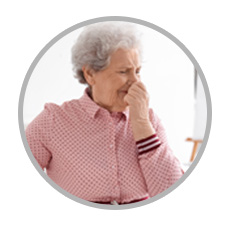
Guide to controlling odours and infection in Care Homes
Are odours a problem?

Bad smells are often a result of bacteria, nature’s warning sign. If a foodstuff has a foul odour, then we know instinctively it’s not safe, in the same way unpleasant odours in a care home can indicate an unhealthy environment. Care homes with odours are at an increased risk of exposing residents, visitors and staff to illness, so it’s essential to take action.
Aside from the potential increase in illness, a bad odour in any environment asks a lot of questions; Where is that smell coming from? Who fault is it? Who is dealing with it? Why has it been allowed? Is it due to poor cleaning? Is it a sign of poor standards? Or poor management?
Any odours are instantly noticeable to visitors in Care Homes. Staff and residents become acclimatized to the environment and it can make it harder to quickly identify and eliminate the source of any bad smells.
Families choosing a care home are not going to select a home with strong odours if they have any other option. “Are there any unpleasant smells?” is on the Alzheimer’s Society first impressions checklist as a sign of how a home is run.
Regulation 15 of the Health and Social Care Act regulations specifically relate to cleanliness. The Care Quality Commission (CQC) state that “Premises and equipment should be visibly clean and free from odours that are offensive or unpleasant”, so any such issues will result in an inadequate rating and even further measures.  Well run Outstanding rated homes will address any odours as a priority to ensure they maintain their reputation, remain at full capacity and maximise the income from every bed.
Well run Outstanding rated homes will address any odours as a priority to ensure they maintain their reputation, remain at full capacity and maximise the income from every bed.
Why odours challenges exist?
Certain odours will always be a challenge, whilst good cleaning practices are an obvious requirement it’s often not understood how bacteria spreads and how quickly it replicates.
Continence issues are a well-known source of odours in care, but use of commodes and standard toilet facilities will all contribute. Challenges with personal hygiene increase body odours. Aromas from food can be very pleasant to begin with, but quickly add to stale odours in certain homes. Illness/vomit as well as infected wounds can all be sources. With many people in a relatively limited space odours can quickly build up if not managed correctly.

Source info:
Alzheimers society
Selecting and moving into a care home | Alzheimer's Society (alzheimers.org.uk)
690 Selecting and moving into a care home (alzheimers.org.uk)
CQC Care Quality Commission
Regulation 15: Premises and equipment - Care Quality Commission (cqc.org.uk)
Why can’t traditional cleaning methods control bacteria, watch the video
Resolving Odour Issues
It can be tempting to try and cover odours with fragrances or masking products, but in time these make the air staler and more unpleasant, in some instances even causing health issues with asthma or allergies. Fragrances are not addressing the cause of the problem, bacteria remains in the air and odours will persist.



